- Home
- About
- Map
- Trips
- Bringing Boat West
- Migration West
- Solo Motorcycle Ride
- Final Family XC Trip
- Colorado Rockies
- Graduates' XC Trip
- Yosemite & Nevada
- Colorado & Utah
- Best of Utah
- Southern Loop
- Pacific Northwest
- Northern Loop
- Los Angeles to NYC
- East Coast Trips
- Martha's Vineyard
- 1 Week in Quebec
- Southeast Coast
- NH Backpacking
- Martha's Vineyard
- Canadian Maritimes
- Ocracoke Island
- Edisto Island
- First Landing '02
- Hunting Island '02
- Stowe in Winter
- Hunting Island '01
- Lake Placid
- Chesapeake
- Provincetown
- Hunting Island '00
- Acadia in Winter
- Boston Suburbs
- Niagara Falls
- First Landing '99
- Cape Hatteras
- West Coast Trips
- Burning Man
- Utah Off-Roading
- Maui
- Mojave 4WD Course
- Colorado River Rafting
- Bishop & Death Valley
- Kauai
- Yosemite Fall
- Utah Off-Road
- Lost Coast
- Yosemite Valley
- Arizona and New Mexico
- Pescadero & Capitola
- Bishop & Death Valley
- San Diego, Anza Borrego, Joshua Tree
- Carmel
- Death Valley in Fall
- Yosemite in the Fall
- Pacific Northwest
- Utah Off-Roading
- Southern CA Deserts
- Yosemite & Covid
- Lake Powell Covid
- Eastern Sierra & Covid
- Bishop & Death Valley
- Central & SE Oregon
- Mojave Road
- Eastern Sierra
- Trinity Alps
- Tuolumne Meadows
- Lake Powell Boating
- Eastern Sierra
- Yosemite Winter
- Hawaii
- 4WD Eastern Sierra
- 4WD Death Valley +
- Southern CA Deserts
- Christmas in Tahoe
- Yosemite & Pinnacles
- Totality
- Yosemite & Sierra
- Yosemite Christmas
- Yosemite, San Diego
- Yosemite & North CA
- Seattle to Sierra
- Southwest Deserts
- Yosemite & Sierra
- Pacific Northwest
- Yosemite & South CA
- Pacific Northwest
- Northern California
- Southern Alaska
- Vancouver Island
- International Trips
- Index
- Tips
- Books
- Photos/Videos
- Search
- Contact
Andean Cloud Forest, Ecuador
Wednesday, March 15, 2023 - 2:30pm by Lolo
0 miles and 0 hours from our last stop - 1 night stay
Travelogue
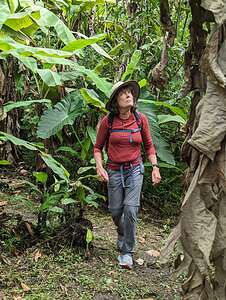 Lolo of the Cloud ForestBesides the 11-day cruise in the Galapagos, Galapagos Travels offers several excursions from Quito, such as trips to the Amazon, Volcanoes, the Bellavista Cloud Forest, etc.
Lolo of the Cloud ForestBesides the 11-day cruise in the Galapagos, Galapagos Travels offers several excursions from Quito, such as trips to the Amazon, Volcanoes, the Bellavista Cloud Forest, etc.
We chose to take the 2-day excursion to the Bellavista Cloud Forest, located near the top of the famed Tandayapa Valley, within the Andean cloud forest region, a type of mid-altitude tropical rainforest that extends from 3,000 to 8,000 feet elevation. The Bellavista Reserve stands at 7,300 feet.
Cloud forests are like rain forests in that they both receive high levels of precipitation. However, the cloud forests get much of their precipitation directly from the clouds that filter through the trees.
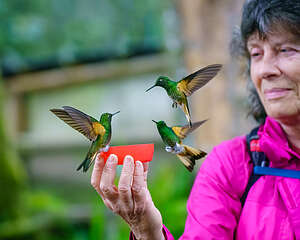 The hummingbird whispererThese consistent clouds are the result of transpiration of humid air from the billions of trees in the lowland Amazon moving up the mountain slopes of the Andes, condensing and falling as rain or remaining in the form of low clouds and mist. The atmospherics are truly magical.
The hummingbird whispererThese consistent clouds are the result of transpiration of humid air from the billions of trees in the lowland Amazon moving up the mountain slopes of the Andes, condensing and falling as rain or remaining in the form of low clouds and mist. The atmospherics are truly magical.
Although cloud forests account for only 1% of global woodland, they have an incredible amount of biodiversity. The Ecuadorian cloud forests are considered the single richest hotspot on the planet, containing 17% of the world’s plant species, including thousands of species of orchids and nearly 20% of its bird diversity.
In order to take full advantage of our day (and especially early morning when the wildlife is more active), our guide picked us up at the hotel at 6:00 a.m. and we drove with three other of our tour group colleagues (Tom, Steve, and Bircan) on the winding roads to Bellavista Lodge (90 minutes west of Quito) where we would be spending the night. The final 12 kilometers of the drive was along a very bumpy dirt road.
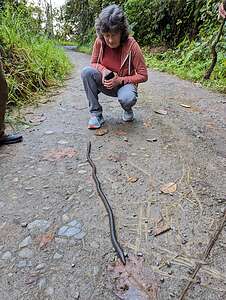 Giant EarthwormOur driver stopped and let us out when we came upon a giant 4-foot earthworm crossing the road, making me wonder if the earthworms were this big, what was the rest of the fauna going to be like.
Giant EarthwormOur driver stopped and let us out when we came upon a giant 4-foot earthworm crossing the road, making me wonder if the earthworms were this big, what was the rest of the fauna going to be like.
We continued on to the Bellavista Cloud Forest Lodge, our home for the night, where we were greeted by Alfredo, our naturalist guide. After quickly dropping off our luggage in our cabin, which was lovely with a separate sitting room with big windows looking out over the forest, we met for breakfast in the Lodge restaurant - our second breakfast of the day.
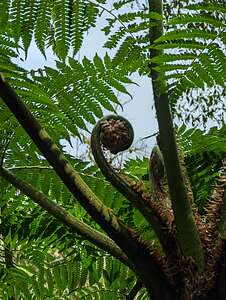 Tree FernNo time was wasted, and once breakfast was complete, we met by the hummingbird feeders and then set out with Alfredo to walk the trails of the Bellavista Reserve.
Tree FernNo time was wasted, and once breakfast was complete, we met by the hummingbird feeders and then set out with Alfredo to walk the trails of the Bellavista Reserve.
Armed with just my Google Pixel 7 Pro cellphone as my camera, I admit to having a bit of lens envy as I looked at the rest of the group’s camera equipment. Closeups of faraway or flying birds were definitely not going to be my forte on this stroll, so I decided to focus (no pun intended) on hummingbirds and the interesting flora. I would leave the toucans to Herb.
Cloud forests are the perfect habitat for epiphytes (sometimes known as air plants), which are plants that grow on other plants. The trees in the forest are festooned with bromeliads, orchids, mosses, and more.
There were also very interesting little insects and even a tiny frog that was smaller than half an ¼ inch. Not having the long telephoto lenses that my colleagues had, I tried to get up a little too close and personal to him, which caused him to disappear into thin air. Fortunately, Herb got to him before I did.
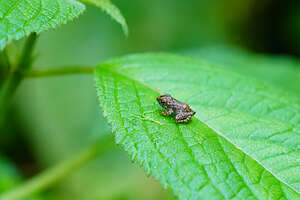 Itsy bitsy frogSince I was having trouble photographing distant birds with my cell phone, I decided to deal with the flora because it stood still. One of my favorites was the Tree Ferns, where their curly fiddleheads (named for obvious reasons). The fiddleheads of a young fern are harvested for a vegetable. Everything in the Andean cloud forest seems to have a use.
Itsy bitsy frogSince I was having trouble photographing distant birds with my cell phone, I decided to deal with the flora because it stood still. One of my favorites was the Tree Ferns, where their curly fiddleheads (named for obvious reasons). The fiddleheads of a young fern are harvested for a vegetable. Everything in the Andean cloud forest seems to have a use.
At one point during our hike, Alfredo stopped us along the trail to allow Steve to make an announcement as to another choice in our itinerary. He asked if we would all be willing to pay an extra $39 pp (which later turned out to be $55 pp) to take an early excursion the next morning to see the “Cock of the Rock.” Never too old for low-form humor, his announcement was greeted with immature giggling from the rest of us. It got worse when Steve described the bird as being larger than 6 inches with a funny-looking head, which brought us to our knees. Knowing him better later, I realized he knew exactly how to get a reaction from the crowd. I love British humor.
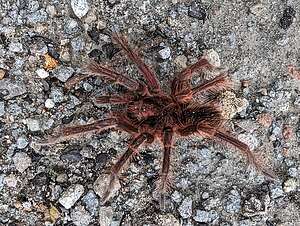 Oh my!We all agreed that we absolutely must see the “Cock.”
Oh my!We all agreed that we absolutely must see the “Cock.”
When we got back near the lodge, we were greeted in the parking lot by a big hairy tarantula. I had never seen one up close and personal before, so it was a little bit exciting. I just hoped he wouldn't find his way to our room.
After our walk, we spent some time at the hummingbird feeders where there are 15 different species zipping and buzzing around, often landing on us. Their tiny little feet gripping my finger felt really weird and I had to stop myself from shaking it off.
Alfredo tried to set up a more natural setting than a feeder for them to land on by pouring sugar water over a stalk with flowers, but they weren’t buying it. Instead they landed on his shoulder and watched his efforts.
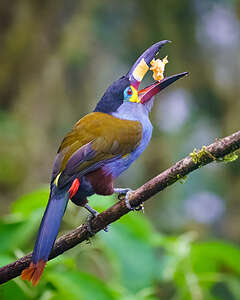 Plate-billed mountain toucanThere was also a beautiful toucan nearby enjoying a piece of a banana, pieces of which are left around the lodge to attract birds. Based on its coloring I think it was a plate-billed mountain toucan, which is only found in the Andean cloud forest in northwestern Ecuador.
Plate-billed mountain toucanThere was also a beautiful toucan nearby enjoying a piece of a banana, pieces of which are left around the lodge to attract birds. Based on its coloring I think it was a plate-billed mountain toucan, which is only found in the Andean cloud forest in northwestern Ecuador.
It was starting to rain a bit, as it does almost every day after 2 p.m., so we returned to our lovely cabin and had a very cozy siesta on the daybed in our sitting room before having to join the rest of the group for dinner at the Lodge.
After dinner, we were supposed to take a night walk to see a bird that returns to sit on its egg at night, but it was raining pretty hard. No one wanted to be the first to say they didn’t want to go, but once one of us did, everyone else quickly followed suit. Besides, we had a very early morning ahead of us to drive to a place to see the “Cock of the Rock.”
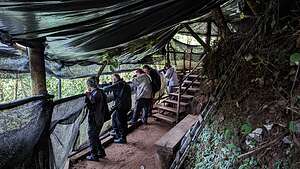 Cock of the Rock blindThe next morning,we left before sunrise (and breakfast) to drive the 50 minutes to the Reserva la Victoriana, a private reserve where there is a lek (communal gathering spot for male “Cock of the Rock” birds). There are only a few leks scattered throughout the Andean Cloud Forest.
Cock of the Rock blindThe next morning,we left before sunrise (and breakfast) to drive the 50 minutes to the Reserva la Victoriana, a private reserve where there is a lek (communal gathering spot for male “Cock of the Rock” birds). There are only a few leks scattered throughout the Andean Cloud Forest.
As the sun rose, we marched through a very different topography than at Bellavista - much more expansive views and different vegetation. In a little less than a half mile we arrived at a blind and immediately began hearing the screeching sound of the male Cock of the Rock, coming from the ravine below us. Their call has sometimes been compared to the sound a screaming robot might make.
 Cock of the RockAs with most birds, male is much more attractive with a brilliant red-orange plumage, black and white wings, purple on his back, and a large fan-like crest that almost completely obscures his bill. Known as tunki in Quechua, he is the national bird of Peru. In comparison, the more drab female is darker and browner.
Cock of the RockAs with most birds, male is much more attractive with a brilliant red-orange plumage, black and white wings, purple on his back, and a large fan-like crest that almost completely obscures his bill. Known as tunki in Quechua, he is the national bird of Peru. In comparison, the more drab female is darker and browner.
Males gather at communal gathering spots called leks, which are usually down in a ravine near a stream. It is at these leks that they compete for breeding females with each male displaying his colorful plumage, bobbing and hopping, and making a variety of bizarre squeaking and grunting sounds.
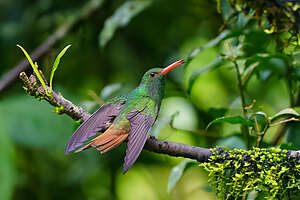 Hummingbird at the Alambi PreserveAfter mating, the female makes a nest under a rocky overhang, incubates the eggs, and rears the young by herself. Hence, the “Rock” part of this bird’s name.
Hummingbird at the Alambi PreserveAfter mating, the female makes a nest under a rocky overhang, incubates the eggs, and rears the young by herself. Hence, the “Rock” part of this bird’s name.
The birds were too far away and too fast for me to capture a good image with my cell phone, but I did enjoy passing the hour watching their antics (both the birds and the photographers). Thankfully, after probably hundreds of attempts, Herb was able to capture some great images.
After breakfast, we continued on to the Alambi Preserve, a family project for the conservation of the cloud forest in the famous Tandayapa Valley. It was a very different experience than our early morning trek to get to the Cock of the Rock lek to hear and watch them do their mating display.
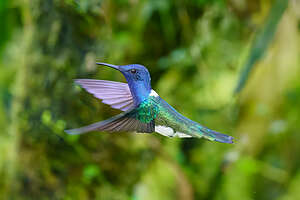 Hummingbird at the Alambi PreserveMuch less wild, the Alambi Preserve had beautifully gardens with beautiful endemic varieties and a hummingbird garden, where one could sit in a chair and watch 30 different species of hummingbirds visit the 8 hummingbird feeders.
Hummingbird at the Alambi PreserveMuch less wild, the Alambi Preserve had beautifully gardens with beautiful endemic varieties and a hummingbird garden, where one could sit in a chair and watch 30 different species of hummingbirds visit the 8 hummingbird feeders.
They were fascinating to watch and I discovered the joy of slow motion video and the interesting effect of slowing down their frantic wing beating from 70 flaps per second to more like 5 times. That entertained me for almost an hour.
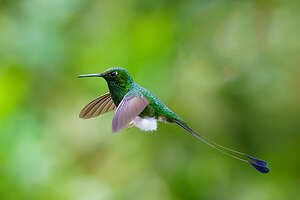 Booted Rackettail hummingbirdHerb got some beautiful photos of hummingbirds in flight. My absolute favorite was of the one with the strange tail feathers that looked like little flippers or boots. I later was able to identify it as a Booted Rackettail, because of what looked like little boots at the end of his tail.
Booted Rackettail hummingbirdHerb got some beautiful photos of hummingbirds in flight. My absolute favorite was of the one with the strange tail feathers that looked like little flippers or boots. I later was able to identify it as a Booted Rackettail, because of what looked like little boots at the end of his tail.
I eventually pulled myself away from the hummingbirds, and wandered through a lovely garden with many varieties of beautiful endemic plants. Everyone was still behind at the hummingbird feeders, so I had the garden to myself.
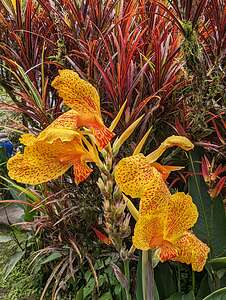 Canna Yellow King HumbertI am no botanist, but you didn’t have to be one to appreciate these beautiful and unique plants. I had no idea what I was seeing at the time, but since coming home I have used Google Lens to identify them.
Canna Yellow King HumbertI am no botanist, but you didn’t have to be one to appreciate these beautiful and unique plants. I had no idea what I was seeing at the time, but since coming home I have used Google Lens to identify them.
Canna “Yellow King Humbert” - rich deep yellow flowers, copiously splashed with fiery orange. The brilliant blossoms contrast nicely with a lush foliage of large, lamp shaped, apple green leaves. The contrast between its bright yellows and oranges was accentuated by the lovely tall red blades growing behind it.
Right nearby was a Heliconia Psittacorum - Erect, evergreen perennial with dense tufts of bright green leaves with pointy tips. The clusters of flowers are quite distinctive and range in colorful use of red, orange, yellow and green. The flowers produce and abundance of nectar and the color.
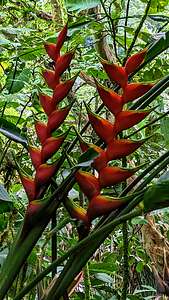 Heliconia CaribaeaEven the vines were works of art. Sanchezia Speciosa - an evergreen shrub that grows in the shady understory of tropical forests. The large variegated leaves have defined yellow veins and grow in an alternating pattern on the stems.
Heliconia CaribaeaEven the vines were works of art. Sanchezia Speciosa - an evergreen shrub that grows in the shady understory of tropical forests. The large variegated leaves have defined yellow veins and grow in an alternating pattern on the stems.
Next, near the hydrangea, I came across what looked like a bowl of rich, dark green leaves filled with hundreds of light green peas, which I later learned were hydrangea buds.
My all time favorite, however, was the Heliconia Caribaea, a large evergreen perennial with huge, oblong, leathery, dark green leaves and spectacular red flowers (6 to 8 inch long), which are actually modified leaves in the shape of lobster claws. I had never seen anything like them.
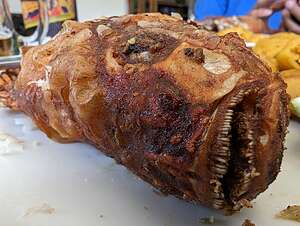 Tilapia as the locals like itWe ended our Cloud Forest excursion with a nice lunch at the Alambi Preserve restaurant. The waitress was a bit difficult to understand, so when Tom, one of our Galapagos Travel colleagues, who is admittedly not a very adventurous eater, asked if the tilapia was breaded, she answered “bones.” Tom was silent for a brief moment, obviously confused as to her reply, but eventually said “okay.”
Tilapia as the locals like itWe ended our Cloud Forest excursion with a nice lunch at the Alambi Preserve restaurant. The waitress was a bit difficult to understand, so when Tom, one of our Galapagos Travel colleagues, who is admittedly not a very adventurous eater, asked if the tilapia was breaded, she answered “bones.” Tom was silent for a brief moment, obviously confused as to her reply, but eventually said “okay.”
One of the biggest laughs I had the entire trip, was watching Tom’s face when this was placed before him. I can still crack up just remembering the expression on his face.
Then it was back to the Mercure Alameda Hotel. Tomorrow was the big day - our flight from Quito to the Galapagos. Since there are a lot of additional security checks and procedures to go through when going to the Galapagos, it was going to be another early to bed night with a very early morning departure. All we had time for was dinner at the hotel’s Spicy Bistro restaurant, which was very good.
- ‹ previous
- 2 of 13
- next ›
Andean Cloud Forest location map in "high definition"
Javascript is required to view this map.
